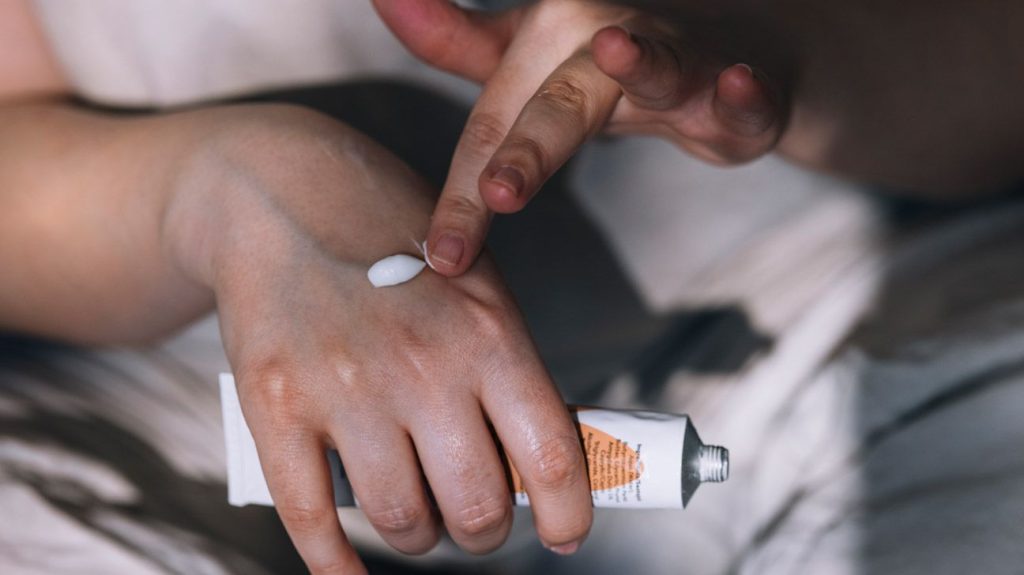Triamcinolone Acetonide for Eczema: How it Works and Side Effects
جدول المحتويات
Triamcinolone acetonide (TA) is a corticosteroid medication that can help control inflammation. If you have eczema, it can help alleviate symptoms like redness and itching.

Triamcinolone Acetonide for Eczema: How it Works and Side Effects
While TA can help treat eczema, it can cause side effects, so it may not be suitable for everyone. All medications have possible side effects, and a doctor can help you decide what’s right for you.
This article outlines how TA can help your eczema and gives tips on how to use it properly. We also discuss the possible risks, side effects, and interactions.
What is triamcinolone acetonide used for?
Triamcinolone acetonide (TA) belongs to a class of medications called glucocorticoids. These suppress your body’s inflammatory response, so they can help manage inflammatory skin conditions like eczema.
TA is a derivative of a molecule called triamcinolone, but it has a much greater potency. This means it’s stronger, making it a more effective treatment.
Topical triamcinolone can help treat eczema and other skin conditions, including:
- contact dermatitis
- dermatitis herpetiformis
- psoriasis
- lichen planus
How to use Triamcinolone acetonide
The Food and Drug Administration (FDA) provides information on topical TA dosage and administration. However, always follow the doctor’s prescription instructions.
The FDA dosing information is as follows:
- 0.025% cream: Apply to affected areas two to four times daily.
- 0.1% cream: Apply to affected areas two to three times daily.
- 0.5% cream: Apply to affected areas two to three times daily.
For eczema that is difficult to manage, you might want to use occlusive dressings after applying cream.
To do this, gently rub a small amount of cream until it disappears into the skin. Reapply a thin layer of the cream and cover it with a flexible, nonporous dressing, مثل plastic wrap. Be sure to seal the edges.
If you want to try occlusive dressings, ask a doctor for advice on when to change the dressings. They may recommend 12-hour occlusion, which involves applying the cream and dressings in the evening and removing them in the morning.
Risks of Triamcinolone acetonide
TA can help with eczema, but it isn’t suitable for everyone. It’s essential always to follow the doctor’s instructions because there are risks associated with overuse.
Before using this medication, speak with a doctor if you:
- have allergies
- are taking other medications or supplements
- have an infection in your mouth or throat
- have ever had diabetes or Cushing syndrome
- are pregnant, planning on becoming pregnant, or nursing
Children may have a higher risk of developing certain conditions after using topical corticosteroids, so it’s important to be aware of them. Some possible complications include:
- Hypothalamic-pituitary-adrenal (HPA) axis suppression: This can cause stunted growth and mean a child doesn’t gain weight quickly enough.
- Cushing syndrome: This may cause delayed growth, weight gain, and high blood pressure.
- Intracranial hypertension: This can cause headaches and swelling of the optic nerve, which is in the eyes.
Speak with a doctor immediately if a child develops new symptoms while using topical corticosteroids.
Side effects of Triamcinolone acetonide
TA cream can cause reactions where it’s applied. These reactions are more likely to occur if you use occlusive dressings.
Adverse skin reactions
Topical TA may cause adverse skin reactions, such as:
Other side effects of Triamcinolone acetonide
Triamcinolone may cause additional side effects. Call a doctor immediately if you experience serious side effects like:
According to a 2023 review, long-term use of topical TA or other glucocorticoids can cause Cushing syndrome. This condition can cause:
Possible interactions of Triamcinolone acetonide
There are no reports of serious interactions between topical TA and other medications.
However, oral and injectable forms of TA may interact with other medications you’re taking. Some medications that can interact with these forms of TA include:
The above list is not exhaustive, so always speak with a doctor before starting a new medication.
Frequently Asked Questions: Topical Corticosteroids for Skin Conditions
What are topical corticosteroids and how do they work?
Topical corticosteroids are anti-inflammatory medications used to treat various skin conditions. They work by:
- Suppressing the body’s inflammatory response
- Reducing redness, itching, and swelling
- Helping to manage symptoms of conditions like eczema, psoriasis, and dermatitis
These medications belong to a class called glucocorticoids, which are known for their potent anti-inflammatory effects.
How should I apply topical corticosteroids?
To use topical corticosteroids effectively:
Always follow your healthcare provider’s instructions for proper use.
What are the potential risks of using topical corticosteroids?
While effective, topical corticosteroids carry some risks, especially with long-term use:
It’s crucial to use these medications as prescribed and discuss any concerns with your doctor.
Can topical corticosteroids cause adverse skin reactions?
Yes, some users may experience adverse skin reactions, including:
If you experience persistent or severe reactions, consult your healthcare provider.
Are there systemic side effects associated with topical corticosteroids?
While less common than local reactions, systemic side effects can occur, especially with long-term or extensive use.
These risks underscore the importance of using topical corticosteroids under medical supervision.
Do topical corticosteroids interact with other medications?
While topical corticosteroids generally have fewer interactions than oral or injectable forms, it’s important to:
Always consult your doctor or pharmacist about potential interactions.
How can I maximize the benefits and minimize the risks of topical corticosteroids?
To get the most out of your treatment while minimizing risks:
Remember, topical corticosteroids can be highly effective when used appropriately under medical guidance.
الخط السفلي
Topical triamcinolone acetonide (TA) is a corticosteroid medication that can help manage inflammatory skin conditions like eczema. It can help alleviate symptoms such as skin redness and itching.
Before using TA cream, tell your doctor about your health conditions and all other medications and supplements you’re taking.
It’s also important to talk with a doctor if you develop adverse skin reactions or side effects while using the cream.








I’ve used Triamcinolone Acetonide for my eczema, and it really helped calm the inflammation quickly. However, I did experience some thinning of the skin with prolonged use. It’s definitely effective, but make sure to follow your doctor’s instructions closely to minimize side effects!
Thanks for the detailed explanation! Triamcinolone Acetonide has been a game-changer for my eczema. While it’s effective in reducing inflammation and itching, I do worry about potential side effects like skin thinning with long-term use. Your balanced overview really helps put things in perspective.
This is a very informative post! Triamcinolone Acetonide has been a game-changer for my eczema. It’s amazing to see an in-depth explanation of how it works to reduce inflammation and suppress the immune system response. However, it’s always good to be aware of the potential side effects, especially with long-term use. Thanks for shedding light on both the benefits and the risks associated with this treatment!
Thank you for sharing this detailed information on Triamcinolone Acetonide for eczema! It’s great to understand how this medication works and be aware of its potential side effects. As someone dealing with eczema, this article provides valuable insights that can help in discussing treatment options with my healthcare provider. Keep up the informative posts!